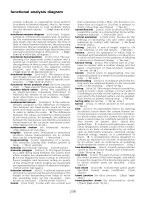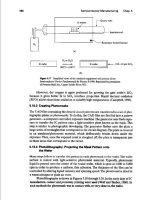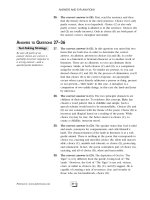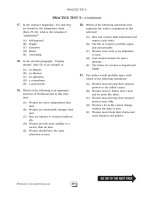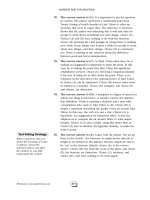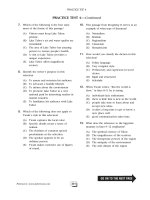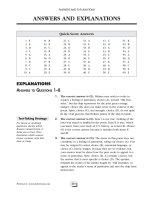SAT II success literature Episode 2 Part 1 ppsx
Bạn đang xem bản rút gọn của tài liệu. Xem và tải ngay bản đầy đủ của tài liệu tại đây (121.81 KB, 20 trang )
Practice Test 2
ANSWER SHEET
Leave any unused
answer spaces blank.
Test Code
V
ÞO
1
ÞO
2
ÞO
3
ÞO
4
ÞO
5
ÞO
6
ÞO
7
ÞO
8
ÞO
9
W ÞO
1
ÞO
2
ÞO
3
ÞO
4
ÞO
5
ÞO
6
ÞO
7
ÞO
8
ÞO
9
X ÞO
1
ÞO
2
ÞO
3
ÞO
4
ÞO
5
Y ÞO
A
ÞO
B
ÞO
C
ÞO
D
ÞO
E
Q ÞO
1
ÞO
2
ÞO
3
ÞO
4
ÞO
5
ÞO
6
ÞO
7
ÞO
8
ÞO
9
Subject Test (print)
FOR ETS
USE ONLY
R/C W/S1 FS/S2 CS/S3 WS
1 O
A
O
B
O
C
O
D
O
E
2 O
A
O
B
O
C
O
D
O
E
3 O
A
O
B
O
C
O
D
O
E
4 O
A
O
B
O
C
O
D
O
E
5 O
A
O
B
O
C
O
D
O
E
6 O
A
O
B
O
C
O
D
O
E
7 O
A
O
B
O
C
O
D
O
E
8 O
A
O
B
O
C
O
D
O
E
9 O
A
O
B
O
C
O
D
O
E
10 O
A
O
B
O
C
O
D
O
E
11 O
A
O
B
O
C
O
D
O
E
12 O
A
O
B
O
C
O
D
O
E
13 O
A
O
B
O
C
O
D
O
E
14 O
A
O
B
O
C
O
D
O
E
15 O
A
O
B
O
C
O
D
O
E
16 O
A
O
B
O
C
O
D
O
E
17 O
A
O
B
O
C
O
D
O
E
18 O
A
O
B
O
C
O
D
O
E
19 O
A
O
B
O
C
O
D
O
E
20 O
A
O
B
O
C
O
D
O
E
21 O
A
O
B
O
C
O
D
O
E
22 O
A
O
B
O
C
O
D
O
E
23 O
A
O
B
O
C
O
D
O
E
24 O
A
O
B
O
C
O
D
O
E
25 O
A
O
B
O
C
O
D
O
E
26 O
A
O
B
O
C
O
D
O
E
27 O
A
O
B
O
C
O
D
O
E
28 O
A
O
B
O
C
O
D
O
E
29 O
A
O
B
O
C
O
D
O
E
30 O
A
O
B
O
C
O
D
O
E
31 O
A
O
B
O
C
O
D
O
E
32 O
A
O
B
O
C
O
D
O
E
33 O
A
O
B
O
C
O
D
O
E
34 O
A
O
B
O
C
O
D
O
E
35 O
A
O
B
O
C
O
D
O
E
36 O
A
O
B
O
C
O
D
O
E
37 O
A
O
B
O
C
O
D
O
E
38 O
A
O
B
O
C
O
D
O
E
39 O
A
O
B
O
C
O
D
O
E
40 O
A
O
B
O
C
O
D
O
E
41 O
A
O
B
O
C
O
D
O
E
42 O
A
O
B
O
C
O
D
O
E
43 O
A
O
B
O
C
O
D
O
E
44 O
A
O
B
O
C
O
D
O
E
45 O
A
O
B
O
C
O
D
O
E
46 O
A
O
B
O
C
O
D
O
E
47 O
A
O
B
O
C
O
D
O
E
48 O
A
O
B
O
C
O
D
O
E
49 O
A
O
B
O
C
O
D
O
E
50 O
A
O
B
O
C
O
D
O
E
51 O
A
O
B
O
C
O
D
O
E
52 O
A
O
B
O
C
O
D
O
E
53 O
A
O
B
O
C
O
D
O
E
54 O
A
O
B
O
C
O
D
O
E
55 O
A
O
B
O
C
O
D
O
E
56 O
A
O
B
O
C
O
D
O
E
57 O
A
O
B
O
C
O
D
O
E
58 O
A
O
B
O
C
O
D
O
E
59 O
A
O
B
O
C
O
D
O
E
60 O
A
O
B
O
C
O
D
O
E
61 O
A
O
B
O
C
O
D
O
E
62 O
A
O
B
O
C
O
D
O
E
63 O
A
O
B
O
C
O
D
O
E
64 O
A
O
B
O
C
O
D
O
E
65 O
A
O
B
O
C
O
D
O
E
66 O
A
O
B
O
C
O
D
O
E
67 O
A
O
B
O
C
O
D
O
E
68 O
A
O
B
O
C
O
D
O
E
69 O
A
O
B
O
C
O
D
O
E
70 O
A
O
B
O
C
O
D
O
E
71 O
A
O
B
O
C
O
D
O
E
72 O
A
O
B
O
C
O
D
O
E
73 O
A
O
B
O
C
O
D
O
E
74 O
A
O
B
O
C
O
D
O
E
75 O
A
O
B
O
C
O
D
O
E
76 O
A
O
B
O
C
O
D
O
E
77 O
A
O
B
O
C
O
D
O
E
78 O
A
O
B
O
C
O
D
O
E
79 O
A
O
B
O
C
O
D
O
E
80 O
A
O
B
O
C
O
D
O
E
81 O
A
O
B
O
C
O
D
O
E
82 O
A
O
B
O
C
O
D
O
E
83 O
A
O
B
O
C
O
D
O
E
84 O
A
O
B
O
C
O
D
O
E
85 O
A
O
B
O
C
O
D
O
E
86 O
A
O
B
O
C
O
D
O
E
87 O
A
O
B
O
C
O
D
O
E
88 O
A
O
B
O
C
O
D
O
E
89 O
A
O
B
O
C
O
D
O
E
90 O
A
O
B
O
C
O
D
O
E
91 O
A
O
B
O
C
O
D
O
E
92 O
A
O
B
O
C
O
D
O
E
93 O
A
O
B
O
C
O
D
O
E
94 O
A
O
B
O
C
O
D
O
E
95 O
A
O
B
O
C
O
D
O
E
96 O
A
O
B
O
C
O
D
O
E
97 O
A
O
B
O
C
O
D
O
E
98 O
A
O
B
O
C
O
D
O
E
99 O
A
O
B
O
C
O
D
O
E
100 O
A
O
B
O
C
O
D
O
E
172 Peterson’s SAT II Success: Literature
PRACTICE TEST 2
While you have taken many standardized tests and know to blacken completely the ovals on the
answer sheets and to erase completely any errors, the instructions for the SAT II: Literature Test differ
in an important way from the directions for other standardized tests. You need to indicate on the
answer key which test you are taking. The instructions on the answer sheet will tell you to fill out the
top portion of the answer sheet exactly as shown.
1. Print LITERATURE on the line under the words Subject Test (print).
2. In the shaded box labeled Test Code fill in four ovals:
—Fill in oval 3 in the row labeled V.
—Fill in oval 1 in the row labeled W.
—Fill in oval 1 in the row labeled X.
—Fill in oval D in the row labeled Y.
—Leave the ovals in row Q blank.
Test Code
V
ÞO
1
ÞO
2
Þ ÞO
4
ÞO
5
ÞO
6
ÞO
7
ÞO
8
ÞO
9
W Þ ÞO
2
ÞO
3
ÞO
4
ÞO
5
ÞO
6
ÞO
7
ÞO
8
ÞO
9
X Þ ÞO
2
ÞO
3
ÞO
4
ÞO
5
Y ÞO
A
ÞO
B
ÞO
C
Þ ÞO
E
Q ÞO
1
ÞO
2
ÞO
3
ÞO
4
ÞO
5
ÞO
6
ÞO
7
ÞO
8
ÞO
9
Subject Test (print)
LITERATURE
There are two additional questions that you will be asked to answer. One is “How many semesters of
courses based mainly on English literature have you taken from grade 10 to the present?” The other
question lists course content and asks you to mark those statements that apply to the courses you
have taken. You will be told which ovals to fill in for each question. The College Board is collecting
statistical information. If you choose to answer, you will use the key that is provided and blacken the
appropriate ovals in row Q. You may also choose not to answer, and that will not affect your grade.
When everyone has completed filling in this portion of the answer sheet, the supervisor will tell you
to turn the page and begin. The answer sheet has 100 numbered ovals, but there are only approxi-
mately 60 multiple-choice questions on the test, so be sure to use only ovals 1 to 60 (or however
many questions there are) to record your answers.
173Peterson’s: www.petersons.com
Directions: This test consists of selections of literature and
questions on their content, style, and form. After you have read
each passage, choose the answer that best answers the question
and fill in the appropriate oval on the answer sheet.
Note: Read each question carefully, paying particular attention
to those that contain the words not, least, or except.
Questions 1–11 refer to following excerpt. Read the selection
carefully and then choose the answers to the questions.
From the Third Essay of
Letters from an American Farmer
Line What attachment can a poor European emigrant have for a country
where he had nothing? The knowledge of the language, the love of a
few kindred as poor as himself, were the only cords that tied him: his
country is now that which gives him land, bread, protection, and
consequence. Ubi panis ibi patria* is the motto of all emigrants.
What then is the American, this new man? He is either an European,
or the descendant of an European, hence that strange mixture of
blood, which you will find in no other country. I could point out to
you a family whose grandfather was an Englishman, whose wife was
Dutch, whose son married a French woman, and whose present four
sons have now four wives of different nations. He is an American,
who, leaving behind him all his ancient prejudices and manners,
receives new ones from the new mode of life he has embraced, the
government he obeys, and the new rank he holds. He becomes an
American by being received in the broad lap of our great Alma
Mater.** Here individuals of all nations are melted into a new race of
men, whose labors and posterity will one day cause great changes in
the world. Americans are the western pilgrims, who are carrying
along with them that great mass of arts, sciences, vigor, and industry,
which began long since in the east; they will finish the great circle.
The Americans were once scattered all over Europe; here they are
incorporated into one of the finest systems of population which has
ever appeared, and which will hereafter become distinct by the
power of the different climates they inhabit. The American ought
therefore to love this country much better than that wherein either
he or his forefathers were born. Here the rewards of his industry
* Where bread is, there is one’s country.
** beloved mother
SAT II SUCCESS: LITERATURE
PRACTICE TEST 2—Continued
5
10
15
20
25
174 Peterson’s SAT II Success: Literature
follow with equal steps the progress of his labor; his labor is founded
on the basis of nature, self-interest; can it want a stronger allurement?
Wives and children, who before in vain demanded of him a morsel of
bread, now, fat and frolicsome, gladly help their father to clear those
fields whence exuberant crops are to arise to feed and to clothe them
all; without any part being claimed, either by a despotic prince, a rich
abbot, or a mighty lord. Here religion demands but little of him; a
small voluntary salary to the minister, and gratitude to God; can he
refuse these? The American is a new man, who acts upon principles;
he must therefore entertain new ideas, and form new opinions. From
involuntary idleness, servile dependence, penury, and useless labor,
he has passed to toils of a very different nature, rewarded by ample
subsistence.—This is an American.
—Hector St. John de Crèvecoeur
1. Which statement best presents the writer’s
theme?
(A) Americans will become self-serving.
(B) The American people will sabotage
their own country through their
excesses.
(C) The new nation will cause changes in
other countries around the globe.
(D) America will evolve into an inflexible
class structure.
(E) The new nation will exhibit imperial-
istic tendencies.
2. Which of the following best describes the
author’s view of America?
(A) A melting pot
(B) Contumacious
(C) Class conscious
(D) Devoid of ethical codes
(E) Lacking bias
3. How can this selection be best character-
ized?
(A) An articulate presentation of the
American dream
(B) An erudite critique of the new
American nation
(C) An ironic discourse
(D) A fascinating narrative
(E) An invective directed at reforming
European countries
4. Which of the following best describes this
selection’s organization?
(A) Order of importance
(B) Developmental
(C) Chronological
(D) Spatial
(E) Compare/contrast
PRACTICE TEST 2
PRACTICE TEST 2—Continued
30
35
➡
GO ON TO THE NEXT PAGE
175Peterson’s: www.petersons.com
5. Which of the following is not a reason for
Americans to love this country more than
that of their ancestors?
(A) America is one of the most diverse
nations in history.
(B) The labor of Americans is founded
upon their own self-interest.
(C) Religion demands little of them.
(D) Rewards follow their labor.
(E) Charity is freely given.
6. Which of the following best characterizes
the tone of the selection?
(A) Pedantic and dry
(B) Wistful yet with little hope
(C) Compelling and positive
(D) Condescending and lacking in feeling
(E) Satirical and snide
7. How does the author describe the “Ameri-
can”?
(A) A class-conscious individual
(B) A person with new principles
(C) An indolent individual
(D) An effete person
(E) An industrious worker
8. Which of the following is not an element
of the writer’s style?
(A) Use of present tense
(B) Parallel construction
(C) Simple sentences
(D) Rhetorical sentences
(E) Classical phrases
9. What does de Crèvecoeur say he had in
common with Americans when he came to
this country?
(A) Religious faith and culture
(B) Education and aspirations
(C) Language and impoverished relatives
(D) Occupational skills and some wealth
(E) Wife and children
10. Which of the following is a source of new
prejudices that an American will embrace?
(A) Class structure
(B) National origin
(C) Race and ethnic background
(D) American government
(E) Religion
11. What is the best synonym for the word
“exuberant” in the sentence that begins
“Wives and children, who before in vain
. . .” (lines 29–33)?
(A) Meager
(B) Plentiful
(C) Cultivated
(D) Shriveled
(E) Enthused
SAT II SUCCESS: LITERATURE
PRACTICE TEST 2—Continued
176 Peterson’s SAT II Success: Literature
Questions 12–21 refer to the following poem written during the
Victorian period. Read the poem carefully and then answer the
questions.
My Last Duchess
Line That’s my last Duchess painted on the wall.
Looking as if she were alive. I call
That piece a wonder, now: Frà Pandolf’s hands
Worked busily a day, and there she stands.
Will’t please you to sit and look at her? I said
“Frà Pandolf” by design, for it never read
Strangers like you that pictured countenance.
The depth and passion of its earnest glance,
But to myself they turned (since none puts by
The curtain I have drawn for you, but I)
And seemed as they would ask me, if they durst,
How such a glance came there; so, not the first
Are you to turn and ask thus. Sir, ‘twas not
Her husband’s presence only, called that spot
Of joy into the Duchess’ cheek: perhaps
Frà Pandolf chanced to say “Her mantle lap
Over my lady’s wrist too much,” or Paint
Must never hope to produce the faint
Half-flush that dies along her throat; such stuff
Was courtesy, she thought, and cause enough
For calling up that spot of joy. She had
A heart—how shall I say?—too soon made glad,
Too easily impressed; she liked whate’er
She looked on, and her looks went everywhere.
Sir, ‘twas all one! My favor at her breast,
The dropping of the daylight in the West,
The bough of cherries some officious fool
Broke in the orchard for her, the white mule
She rode round the terrace—all and each
Would draw from her alike the approving speech,
Of blush, at least. She thanked men—good! but thanked
Somehow—I know not how—as if she ranked
My gift of a nine-hundred-years-old name
With anybody’s gift. Who’d stoop to blame
This sort of trifling? Even had you the skill
In speech—(which I have not)—to make your will
Quite clear to such an one, and say. “Just this
PRACTICE TEST 2
PRACTICE TEST 2—Continued
5
10
15
20
25
30
35
➡
GO ON TO THE NEXT PAGE
177Peterson’s: www.petersons.com
Or that in you disgusts me; here you miss,
Or there exceed the mark”—and if she let
Herself be lessoned so, nor plainly set
Her wits to yours, forsooth, and made excuse,
—E’en then would be some stooping; and I choose
Never to stoop. Oh sir, she smiled, no doubt,
Whene’er I passed her, but who passed without
Much the same smile? This grew, I gave commands;
Then all the smiles stopped together. There she stands
As if alive. Will ‘t please you rise? We’ll meet
The company below, then. I repeat
The Count your master’s known munificence
Is ample warrant that no one just pretense
Of mine for dowry will be disallowed;
Though his fair daughter’s self, as I avowed
At starting, is my object. Nay, we’ll go
Together down, sir! Notice Neptune,
Taming a sea horse, thought a rarity
When Claus of Innsbruck cast in bronze for me!
—Robert Browning
12. Which of the following does not describe
the significance of the title?
(A) The title tells you the subject of the
poem.
(B) The title sets the tone of the poem.
(C) The title engages the reader’s
attention.
(D) The title invites the reader’s participa-
tion.
(E) The title makes the first statement
from which we can infer that the
Duchess is out of the Duke’s life.
13. Which of the following best describes the
overall feeling of the poem?
(A) Cruel
(B) Powerful
(C) Depraved
(D) Chilling
(E) Vicious
SAT II SUCCESS: LITERATURE
PRACTICE TEST 2—Continued
40
45
50
55
178 Peterson’s SAT II Success: Literature
14. Which of the following lines demonstrates
that the Duke sees himself as reasonable?
(A) “—E’en then would be some stoop-
ing: and I choose/Never to stoop. Oh
sir, she smiled, no doubt,/Whene’er I
passed her, but who passed without/
Much the same smile?” (lines 42–45)
(B) “ Irepeat/ The Count your
master’s known munificence/ Is
ample warrant that no one just
pretense/ Of mine for dowry will be
disallowed;” (lines 48–51)
(C) “. . . She thanked men—good! but
thanked/ Somehow—I know not
how—as if she ranked/My gift of a
nine-hundred-years-old name/With
anybody’s gift.” (lines 31–34)
(D) “A heart—how shall I say?—too soon
made glad,/Too easily impressed; she
liked whate’er/She looked on, and her
looks went everywhere./Sir, ‘twas all
one!” (lines 22–25)
(E) “. . . Sir, ‘twas not/Her husband’s pres-
ence only, called that spot/Of joy into
the Duchess’ cheek” (lines 13–15)
15. What does the inclusion of the detail of
the bronze sculpture of Neptune taming a
seahorse suggest about the Duke’s charac-
ter?
I. The Duke is a collector of fine art.
II. The Duke sees himself as a powerful
God-like man who tames wild things.
III. The Duke collects objects, of which
the Duchess was one.
(A) I only
(B) II only
(C) III only
(D) I and III
(E) II and III
16. How does the author convey the meaning
of the poem?
(A) Through monologue
(B) Through dialogue
(C) Through control of language and
images
(D) Through the use of concrete images
(E) Through character development
17. The author invites the reader to make
inferences about all of the following
EXCEPT
(A) what the Duke wanted stopped.
(B) the Duke’s character.
(C) the Duchess’ personality.
(D) the details of setting and situation.
(E) the cause of the Duchess’ demise.
PRACTICE TEST 2
PRACTICE TEST 2—Continued
➡
GO ON TO THE NEXT PAGE
179Peterson’s: www.petersons.com
18. Using his unique skills, what is the poet
trying to inspire in the reader?
(A) Antipathy for the Duke
(B) Sympathy for the Duchess
(C) Imaginative participation
(D) A knowledge of the use of imagery in
poetry
(E) An appreciation for the uses of power
by the privileged
19. Which of the following best represents the
key oppositions in the poem?
I. The evil Duke vs. the good Duchess
II. The dead Duchess vs. the “alive”
portrait
III. The alive Duke vs. the dead (soulless)
Duke
(A) I only
(B) II only
(C) III only
(D) I and II
(E) I, II, and III
20. All of the following adjectives describe
both the Duke’s character and the charac-
ter of the Renaissance EXCEPT
(A) sinister.
(B) clever.
(C) powerful.
(D) sophisticated.
(E) self-involved.
21. If the Duke were to talk about himself,
which of the following statements would
he be most likely to make?
(A) I am a Renaissance man.
(B) I like to collect objects of art.
(C) I destroy what I cannot control.
(D) My 900-year-old name is a rare and
precious gift.
(E) I discard that which does not please
me.
SAT II SUCCESS: LITERATURE
PRACTICE TEST 2—Continued
180 Peterson’s SAT II Success: Literature
Questions 22–29 refer to the following poem written during the
Harlem Renaissance. Read the poem carefully and then answer the
questions.
Douglass
Line Ah, Douglass, we have fall’n on evil days,
Such days as thou, not even thou didst know,
When thee, the eyes of that harsh long ago
Saw, salient, at the cross of devious ways,
And all the country heard thee with amaze,
Not ended then, the passionate ebb and flow,
The awful tide that battled to and fro;
We ride amid a tempest of dispraise.
Now, when the waves of swift dissension swarm,
And Honor, the strong pilot, lieth stark,
Oh, for thy voice high-sounding o’er the storm,
For thy strong arm to guide the shivering bark,
The blast-defying power of thy form,
To give us comfort through the lonely dark.
—Paul Laurence Dunbar
22. What type of poem is this?
(A) Petrarchan, or Italian, sonnet
(B) Ballad
(C) Lyric
(D) Shakespearean sonnet
(E) Ode
23. In what way does Dunbar’s use of this
form contribute to the poem’s effective-
ness?
(A) The form brings a musical quality to
the poem.
(B) It helps clarify the ideas.
(C) The problem is explained in the
sestet.
(D) The form conveys a sense of dignity.
(E) It makes the poem seem Elizabethan.
24. Which of the following are elements of the
theme?
I. African Americans are in the midst of
a very bad period.
II. The turmoil of Douglass’ time has not
ended.
III. African Americans need a strong
leader.
(A) I only
(B) I and II
(C) I and III
(D) II and III
(E) I, II, and III
PRACTICE TEST 2
PRACTICE TEST 2—Continued
5
10
➡
GO ON TO THE NEXT PAGE
181Peterson’s: www.petersons.com
25. Who is the speaker in this poem?
(A) Frederick Douglass
(B) An African-American historian
(C) The poet
(D) A despairing African American
(E) A former slave
26. How would you characterize the tone of
“Douglass”?
(A) Sonorous and dark
(B) Despairing yet dignified
(C) Ponderous and dull
(D) Quietly hopeful
(E) Graceful but troubled
27. To what does the speaker compare the
struggles of the black people in lines 6
through 8?
(A) Douglass’s time
(B) The Civil War period
(C) The ocean
(D) Storm clouds
(E) The African-American experience in
twentieth-century United States
28. Identify the type of figurative language
used in lines 4 and 5.
(A) Personification
(B) Hyperbole
(C) Alliteration
(D) Consonance
(E) Assonance
29. What effect does the imagery in lines 8
and 9 create?
(A) The imagery emphasizes the feeling
of troubled times.
(B) It causes the reader to think of
surviving in a stormy ocean.
(C) The lines establish the rhyme scheme.
(D) They provide a light, musical element.
(E) The imagery shows how erudite the
speaker is.
SAT II SUCCESS: LITERATURE
PRACTICE TEST 2—Continued
182 Peterson’s SAT II Success: Literature
Questions 30–39 refer to the following excerpt written in the eighteenth
century. Read the selection carefully and then answer the questions.
From The Life of Samuel Johnson: “Feelings”
Line [Said Johnson:] “Pity is not natural to man. Children are always cruel.
Savages are always cruel. Pity is acquired and improved by the
cultivation of reason. We may have uneasy sensations from seeing a
creature in distress, without pity; for we have not pity unless we
wish to relieve them. When I am on my way to dine with a friend,
and finding it late, have bid the coachman make haste, if I happen to
attend when he whips his horses, I may feel unpleasantly that the
animals are put to pain, but I do not wish him to desist. No, sir, I
wish him to drive on.”
Johnson’s love of little children, which he discovered upon all occa-
sions, calling them “pretty dears,” and giving them sweetmeats, was an
undoubted proof of the real humanity and gentleness of his disposition.
His uncommon kindness to his servants, and serious concern,
not only for their comfort in this world, but their happiness in the
next, was another unquestionable evidence of what all, who were
intimately acquainted with him, knew to be true.
Nor would it be just, under this head, to omit the fondness
which he showed for animals which he had taken under his protec-
tion. I never shall forget the indulgence with which he treated
Hodge, his cat; for whom he himself used to go out and buy oysters,
lest the servants, having that trouble, should take a dislike to the poor
creature. I am, unluckily, one of those who have an antipathy to a
cat, so that I am uneasy when in the room with one; and I own I
frequently suffered a good deal from the presence of this same
Hodge. I recollect him one day scrambling up Dr. Johnson’s breast,
apparently with much satisfaction, while my friend, smiling and
half-whistling, rubbed down his back and pulled him by the tail; and
when I observed he was a fine cat, saying, “Why, yes, sir, but I have
had cats whom I liked better than this;” and then, as if perceiving
Hodge to be out of countenance, adding, “but he is a very fine cat, a
very fine cat indeed.”
This reminds me of the ludicrous account which he gave Mr.
Langton of the despicable state of a young gentleman of good family.
“Sir, when I heard of him last, he was running about town shooting
cats.” And then, in a sort of kindly reverie, he bethought himself of
his own favorite cat, and said, “But Hodge shan’t be shot; no, no,
Hodge shall not be shot.”
—James Boswell
PRACTICE TEST 2
PRACTICE TEST 2—Continued
5
10
15
20
25
30
35
➡
GO ON TO THE NEXT PAGE
183Peterson’s: www.petersons.com
30. In reading the first paragraph, the reader
would gain all of the following impressions
of Johnson EXCEPT
(A) he is a man of strong opinions.
(B) he is a man who knows himself well.
(C) he pities animals.
(D) he is an astute observer of human
nature.
(E) he is honest about himself and his
flaws.
31. What is the subject of this excerpt?
(A) Johnson’s attitude toward animals
(B) Accounts of the nature of Johnson’s
character
(C) Johnson’s idiosyncracies
(D) Johnson’s attitude toward his servants
(E) A commentary on eighteenth-century
life using one man as an example
32. Which of the following best represents the
theme of this selection?
I. Johnson is a man to be admired.
II. All men comprise contradictory
qualities, even great men.
III. Great men like Johnson are not to be
judged as ordinary men are judged.
(A) I only
(B) II only
(C) III only
(D) I and II
(E) II and III
33. The narrator’s attitude toward his subject
can best be described as
(A) admiring.
(B) fawning.
(C) idolizing.
(D) tolerant.
(E) indulgent.
34. All of the following are true about how
Boswell develops his biography EXCEPT
I. accounts of personal dialogues.
II. observations from others.
III. personal observations.
(A) I only
(B) II only
(C) I and II
(D) II and III
(E) I, II, and III
35. The first four sentences in this selection
are good examples of Johnson’s tendency
to speak in
(A) aphorisms.
(B) epigrams.
(C) maxims.
(D) exemplum.
(E) hyperbole.
SAT II SUCCESS: LITERATURE
PRACTICE TEST 2—Continued
184 Peterson’s SAT II Success: Literature
36. What purpose do the second, third, and
fourth paragraphs serve in this selection?
(A) To provide a balance between
Johnson’s virtues and his flaws
(B) To provide details that provide a
broader view of Johnson’s attitude
toward animals
(C) To establish that Johnson had friends
(D) To reassure the reader that Johnson is
not unfeeling
(E) To dismiss any idea that Johnson is a
misanthrope
37. The author uses all of the following
elements of style to paint an accurate
portrait of his subject EXCEPT
(A) interior monologue.
(B) direct quotations.
(C) use of specific details.
(D) use of anecdotes.
(E) a respectful tone.
38. Which of the following is an important
element of Boswell’s style?
(A) Simple sentences
(B) Many allusions
(C) Sonorous cadence
(D) Impartiality
(E) Extensive parallelism
39. What does the phrase “out of counte-
nance” (line 30) mean?
(A) To lose face
(B) To show one’s true feelings
(C) To give a look of disapproval
(D) To lack good humor
(E) To be embarrassed
PRACTICE TEST 2
PRACTICE TEST 2—Continued
➡
GO ON TO THE NEXT PAGE
185Peterson’s: www.petersons.com
Questions 40–45 refer to the following poem written in the United
States during the nineteenth century. Read the poem carefully and
then answer the questions.
To a Waterfowl
Line Whither, midst falling dew,
While glow the heavens with the last steps of day,
Far, through their rosy depths, dost thou pursue
Thy solitary way?
Vainly the fowler’s eye
Might mark thy distant flight to do thee wrong,
As, darkly seen against the crimson sky,
Thy figure floats along.
Seek’st thou the plashy brink
Of weedy lake, or marge of river wide,
Or where the rocking billows rise and sink
On the chafed ocean-side?
There is a Power whose care
Teaches thy way along that pathless coast–
The desert and illimitable air–
Lone wandering, but not lost.
All day thy wings have fanned,
At that far height, the cold, thin atmosphere,
Yet stoop not, weary, to the welcome land,
Though the dark night is near.
And soon that toil shall end;
Soon shalt thou find a summer home, and rest,
And scream among thy fellows; reeds shall bend
Soon, o’er thy sheltered nest.
Thou’rt gone, the abyss of heaven
Hath swallowed up thy form; yet, on my heart
Deeply has sunk the lesson thou hast given,
And shall not soon depart.
He who, from zone to zone,
Guides through the boundless sky thy certain flight,
In the long way that I must tread alone,
Will lead my steps aright.
—William Cullen Bryant
SAT II SUCCESS: LITERATURE
PRACTICE TEST 2—Continued
5
10
15
20
25
30
186 Peterson’s SAT II Success: Literature
40. What message does the poet wish to
communicate in this selection?
(A) Concern for the bird’s destination
(B) Love of nature
(C) Concern about the waterfowl’s fate
(D) Nature as a source of inspiration and
understanding
(E) The beauty of wild things
41. Which of the following images relating to
the waterfowl corresponds to the speaker’s
“long way” (line 31)?
(A) “Thy figure floats along” (line 8)
(B) “thy distant flight” (line 6)
(C) “thy way along that pathless coast”
(line 14)
(D) “thy wings have fanned” (line 17)
(E) “that toil shall end” (line 21)
42. The poet uses figurative language in order
to show the relationship between the
waterfowl and
(A) Divine Providence.
(B) nature’s wild creatures.
(C) nature’s mystery.
(D) the fowler’s target.
(E) nature’s beauty.
43. How does the speaker’s concern with the
waterfowl contrast with the fowler’s
interest in the bird?
I. The speaker wishes the bird to escape,
and the fowler wants to shoot it.
II. The speaker is interested in the bird
as a source of spiritual nourishment,
whereas the fowler is interested in
the waterfowl as a source of bodily
nourishment.
III. The speaker is concerned with the
emotional response created by the
waterfowl; the fowler is concerned
with the intellectual challenge
presented in shooting the bird.
(A) I only
(B) II only
(C) III two only
(D) II and III
(E) I, II, and III
44. All of the following are true about the tone
of “To a Waterfowl” EXCEPT
(A) Emotional
(B) Spiritual
(C) Contemplative
(D) Subjective
(E) Fantastical
45. How would you classify lines 2 through 4?
(A) Vivid imagery
(B) An extended metaphor
(C) Musical devices
(D) Allusion
(E) Direct address
PRACTICE TEST 2
PRACTICE TEST 2—Continued
➡
GO ON TO THE NEXT PAGE
187Peterson’s: www.petersons.com
Questions 46–51 refer to the following poem written during the
English Renaissance. Read the poem carefully and then choose the
best answer for each question.
Easter Wings
Line Lord, who createdst man in wealth and store,
Though foolishly he lost the same,
Decaying more and more,
Till he became
Most poor:
With thee
O let me rise
As larks, harmoniously,
And sing this day thy victories:
Then shall the fall further the flight in me.
My tender age in sorrow did begin.
And still with sickness and shame
Thou didst so punish sin,
That I became
Most thin.
With thee
Let me combine
And feel this day thy victory:
For, if I imp my wing on thine.
Affliction shall advance the fight in me.
—George Herbert
46. What is the meaning of the word “imp” in
line 19?
(A) Mimic
(B) Graft
(C) Cure
(D) Improvise
(E) A lighthearted action
47. Which of the following does not demon-
strate that the physical shape of the poem
echoes its content?
(A) Line 1, suggesting the fullness of
Eden, is a full and abundant line.
(B) As the fall of Adam and Eve is
described, the lines decrease in size,
becoming narrow and poor.
(C) Lines 17 through 20 grow longer to
reflect the wealth of redemption.
(D) The visual shape suggests an altar.
(E) Line 15 echoes the content in the
line.
SAT II SUCCESS: LITERATURE
PRACTICE TEST 2—Continued
5
10
15
20
188 Peterson’s SAT II Success: Literature
48. What is Herbert’s purpose in “Easter
Wings”?
(A) To make an admission of sin and to
send a prayer for redemption
(B) To authenticate the history of
humanity’s spiritual journey
(C) To condemn poverty
(D) To sing a paean to Easter
(E) To chastise the Church of England
49. What does the poet compare in the poem?
(A) The speaker and the Lord
(B) Wealth and decay
(C) Victory and flight
(D) The fall from grace in Eden and the
speaker’s spiritual state
(E) The punishment of sin and sickness
50. In what way is line 10 a paradox?
I. The poet speaks of meagerness, but
the line is one of the longest in the
selection.
II. The line suggests that one can fall
farther than the original fall.
III. The speaker states that the Fall will
make him closer to God.
(A) I only
(B) II only
(C) III only
(D) I and II
(E) I and III
51. How do the title and shape of the poem
reinforce the meaning of the poem?
(A) Both suggest the church.
(B) The wing-like shape is an emblem for
its title, Easter being the time when
the spirit is reborn and able to fly to
God.
(C) The hourglass shape of the poem is
an emblem for passing time, bringing
the speaker closer to heaven.
(D) The title and the shape reflect the
speaker’s hope for a guardian angel.
(E) Both the title and shape suggest the
beauty of nature created by God.
PRACTICE TEST 2
PRACTICE TEST 2—Continued
➡
GO ON TO THE NEXT PAGE
189Peterson’s: www.petersons.com
Questions 52–60 refer to the following excerpt. Read the passage
carefully and then answer the questions.
From Jane Eyre
Line There was no possibility of taking a walk that day. We had been wan-
dering, indeed, in the leafless shrubbery an hour in the morning; but
since dinner (Mrs. Reed, when there was no company, dined early) the
cold winter wind had brought with it clouds so somber and a rain so
penetrating, that further outdoor exercise was now out of the question.
I was glad of it: I never liked long walks, especially on chilly after-
noons: dreadful to me was the coming home in the raw twilight, sad-
dened by chidings of Bessie, the nurse, and humbled by the conscious-
ness of my physical inferiority to Liza, John, and Georgiana Reed.
Then said Eliza, John, and Georgiana were now clustered round
their mamma in the drawing room: she lay reclined on the sofa by
the fireside, and with her darlings about her (for the time neither
quarreling nor crying) looked perfectly happy. Me, she had dispensed
from joining the group; saying, “She regretted to be under the
necessity of keeping me at a distance; but that until she heard from
Bessie and could discover by her own observation that I was endeav-
oring in good earnest to acquire a more sociable and childlike
disposition, a more attractive and sprightly manner—something
lighter, franker, more natural, as it were—she really must exclude me
from privileges intended only for contented, happy, little children.”
“What does Bessie say I have done?” I asked.
“Jane, I don’t like cavilers or questioners; besides, there is some-
thing truly forbidding in a child taking up her elders in that manner. Be
seated somewhere; and until you can speak pleasantly, remain silent.”
A small breakfast room adjoined the drawing room. I slipped in
there. It contained a bookcase: I soon possessed myself of a volume,
taking care that it should be one stored with pictures. I mounted into
the window seat: gathering up my feet, I sat cross-legged like a Turk;
and having drawn the red moreen* curtain nearly closed, I was
shrined in double retirement.
Folds of scarlet drapery shut in my view to the right hand; to
the left were the clear panes of glass, protecting, but not separating
me from the drear November day. At intervals, while turning over the
leaves of my book, I studied the aspect of that winter afternoon. Afar,
it offered a pale blank of mist and cloud; near, a scene of wet lawn
and storm-beat shrub, with ceaseless rain sweeping away wildly
before a long and lamentable blast.
—Charlotte Brontë
* sturdy fabric, often embossed
SAT II SUCCESS: LITERATURE
PRACTICE TEST 2—Continued
5
10
15
20
25
30
35
190 Peterson’s SAT II Success: Literature
